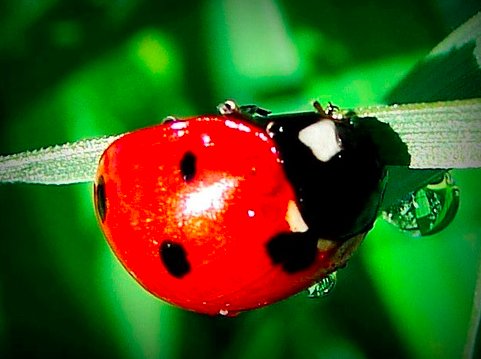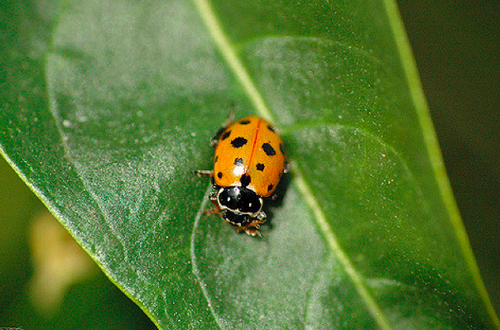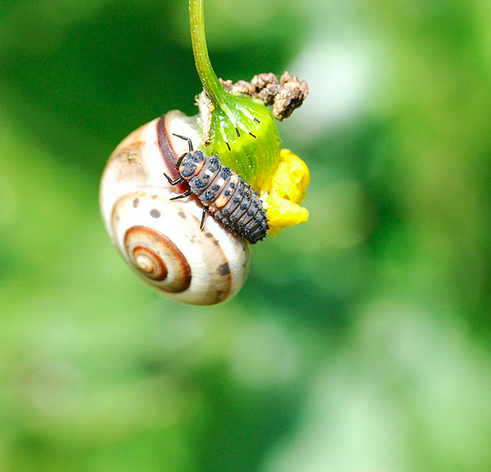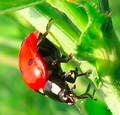
Lady beetles (Coccinellidae), also known as ladybugs or ladybird beetles, are a much loved garden beetle with predatory habits that gardeners appreciate. Lady beetles will consume aphids, thrips, spider mites and scales.[1]
Description[edit | edit source]
The adult lady beetle has a round or ovular shape. The thorax is covered by a plate known as the pronotum, and this conceals the head when the beetle is viewed from above.[1]
The colouring of lady beetles varies from the well-known red to yellows, oranges and black. Not all lady beetles have spots; some have no patterning, while others have splodges or stripes.

The larvae of the lady beetle is long and slim, and covered with spiny protrusions. The legs are short. The colouring varies and includes orange, yellow or white. Some larvae have long hairs or long spikes covering their bodies.

Lady beetles have wings and fly from plant to plant.
Lady beetle types[edit | edit source]
There are many lady beetles around the world, and owing to the fact than many have been introduced to deal with pests, there is widespread mixing of both native and introduced species of lady beetles.
Here is a list of some lady beetles:[1]
- Ash grey/gray lady beetle (Olla v-nigrum)
- Checkerspot or fourteen-spot lady beetle (Propylea quatuordecimpunctata)
- Convergent lady beetle (Hippodamia convergens)
- Eye-spotted lady beetle (Anatis mali)
- Fifteen-spotted lady beetle (Anatis labuculata)
- Giant lady beetle (Anatis lecontei)
- Glacial lady beetle (Hippodamia glacialis)
- Heather lady beetle (Chilocorus bipustulatus)
- Mealybug destroyer (Cryptolaemus montrouzieri)
- Metallic blue lady beetle (Curinus coeruleus)
- Multi-coloured Asian lady beetle (Harmonia axyridis)
- Nine-spotted lady beetle (Coccinella novemnotata)
- Orange-spotted lady beetle (Brachiacantha ursina)
- Parenthesis lady beetle (Hippodamia parenthesis)
- Pink lady beetle (Coleomegilla maculata)
- Poplar lady beetle (Oenopia conglobata)
- Seven-spotted lady beetle (Coccinella spetempunctata)
- Spotless lady beetles (Cycloneda munda, Cycloneda polita and Cycloneda sanguinea)
- Striped lady beetle (Paranaemia vittigera)
- Thirteen-spotted lady beetle (Hippodamia tredecimpunctata)
- Three-banded lady beetle (Coccinella trifasciata)
- Transverse lady beetle (Coccinella transversoguttata)
- Twice-stabbed lady beetle (Chilocorus stigma)
- Two-spot or two-spotted lady beetle (Adalia bipunctata)
- Undulate lady beetle (Hyperaspis undulata)
- Variegated lady beetle (Hippodamia variegata)
- Vedalia beetle (Rodolia cardinalis)
Lady beetles and biological control[edit | edit source]
Lady beetles have been used for a long time by gardeners to control garden pests. For example, in the late 1800s, Vedalia lady beetles were imported and used to control cottony cushion scale in the United States.[1]
Gallery of lady beetles[edit | edit source]
-
Fourteen-spotted lady beetle
-
Variegated lady beetle
-
Two-spotted lady beetle
-
Seven-spotted lady beetle
-
Undulate lady beetle
-
Vedalia beetle
-
Poplar lady beetle
-
Heather lady beetle
Sources and citations[edit | edit source]
- Mary M. Gardiner. (2015) Good Garden Bugs. ISBN 978-1-59253-909-3







